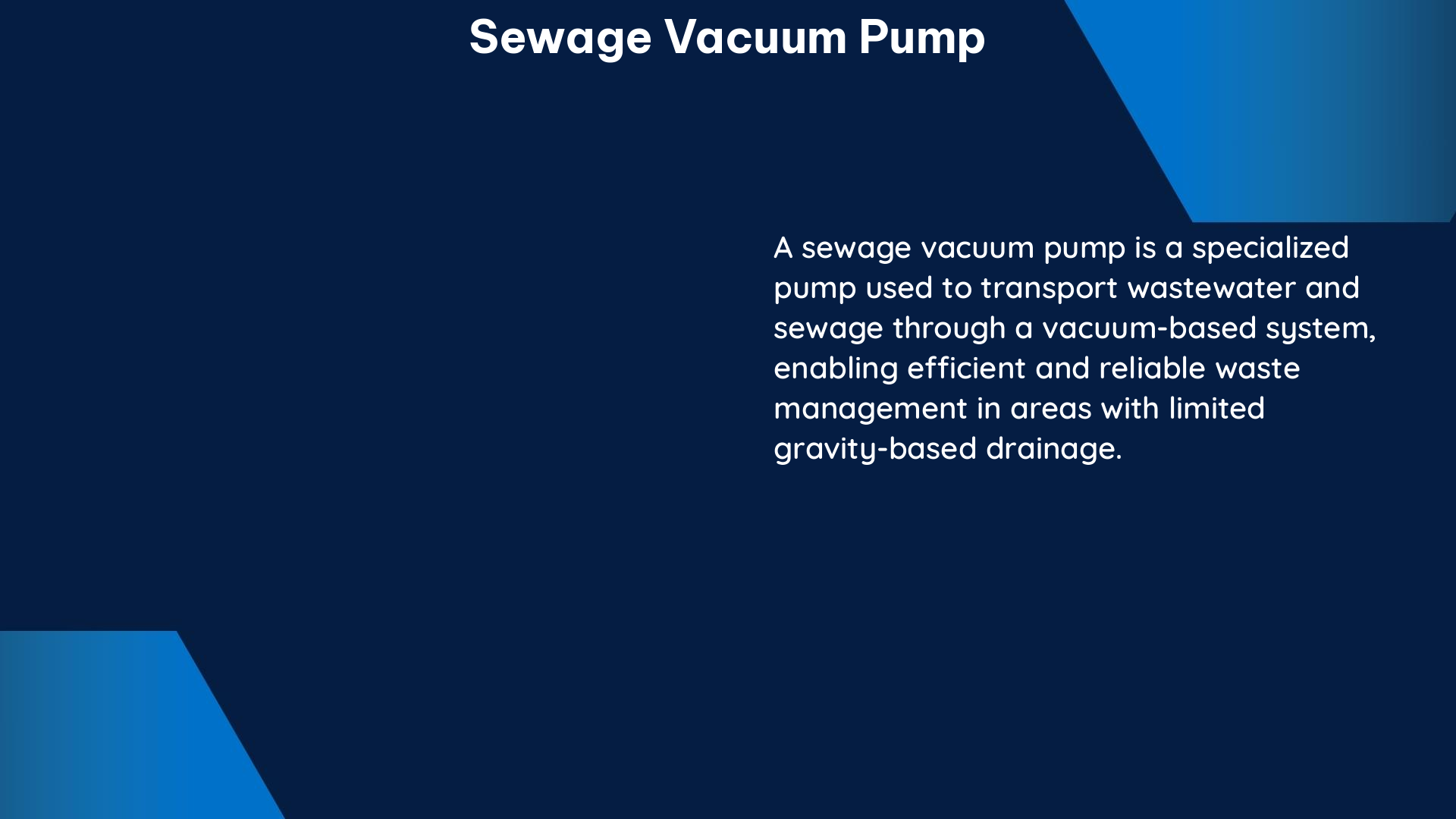Sewage vacuum pumps are crucial components in vacuum wastewater transfer systems, and their performance can be evaluated based on various measurable and quantifiable data. The design criteria for vacuum wastewater transfer systems provide valuable insights into the energy consumption, transport efficiency, and other critical factors that determine the overall effectiveness of these systems.
Energy Consumption
The energy required to transport wastewater through vacuum systems can be measured in watt-hours per gallon (Wh/gal). This value is influenced by several factors, including the air-to-water ratio, the diameter of the transfer lines, and the manner of introducing air at the wastewater generation point.
According to a study conducted by the U.S. Army Corps of Engineers, an experimental test in a 3-inch diameter transport main with a 20-gallon loading showed an energy consumption of approximately 0.07 Wh/gal. This value can be used as a benchmark for evaluating the energy efficiency of a sewage vacuum pump system.
It’s important to note that the energy consumption can vary depending on the specific design and operating conditions of the vacuum system. For instance, a larger diameter transport main or a lower air-to-water ratio can potentially reduce the energy required to move the same volume of wastewater.
Transport Efficiency

Transport efficiency refers to the energy consumed per gallon of wastewater transported. A higher transport efficiency indicates that less energy is required to move a given volume of wastewater, which is desirable for optimizing the overall system performance.
In the same experimental test mentioned above, the transport efficiency was found to be consistent with the performance of a 4-inch diameter transport main when the loading was reduced to 20 gallons. This suggests that the transport efficiency can be improved by adjusting the system design and operating parameters, such as the pipe diameter and the wastewater loading.
Air-to-Water Ratio
The ratio of air to water in the vacuum system significantly affects its performance. A lower air-to-water ratio generally results in more efficient wastewater transport, as it reduces the energy required to move the same volume of wastewater.
In the experimental test, a regression analysis revealed that the energy required to transport wastewater increases with the air-to-water ratio, following the empirical relationship:
E/W = 0.071 + 0.07(air-to-water ratio)
Where:
– E/W is the energy consumed per gallon of wastewater transported (Wh/gal)
– The air-to-water ratio is the dimensionless ratio of air to water in the vacuum system
By understanding and controlling the air-to-water ratio, operators can optimize the energy efficiency of the sewage vacuum pump system.
System Design
Appropriate system design, including the selection of components according to required capacities and the consideration of environmental settings, can minimize the risk of failures and increase the life cycle time of vacuum sewer components.
Key design considerations for sewage vacuum pumps include:
- Pump capacity: Selecting a pump with the appropriate flow rate and head pressure to meet the system’s wastewater transport requirements.
- Pipe diameter: Choosing the optimal pipe diameter to balance energy consumption, transport efficiency, and system capacity.
- Vacuum tank size: Ensuring the vacuum tank is sized to accommodate the expected wastewater flow and provide sufficient air storage.
- Valve configuration: Designing the valve system to effectively control the air-to-water ratio and maintain the desired vacuum pressure.
- Environmental factors: Considering factors such as temperature, humidity, and corrosive environments that can impact the durability and performance of the system components.
By carefully designing the vacuum sewer system, operators can maximize the efficiency and reliability of the sewage vacuum pump.
Preventive Maintenance
Regular inspection, oiling, replacement, cleaning, and other maintenance tasks can increase the durability of the integral parts of the sewage vacuum pump system and minimize the need for emergency actions.
Recommended preventive maintenance activities include:
- Inspecting the pump, motor, and other components for wear and tear
- Lubricating moving parts according to the manufacturer’s recommendations
- Replacing worn or damaged components, such as seals, bearings, and impellers
- Cleaning the vacuum tank, pipes, and other system components to prevent buildup of debris
- Monitoring the system’s performance and making adjustments as needed to maintain optimal efficiency
By implementing a comprehensive preventive maintenance program, operators can extend the lifespan of the sewage vacuum pump and ensure reliable operation over time.
Conclusion
In summary, the performance of sewage vacuum pumps can be evaluated using various measurable and quantifiable data, including energy consumption, transport efficiency, air-to-water ratio, system design, and preventive maintenance practices. By understanding and optimizing these factors, operators can improve the overall efficiency, reliability, and longevity of vacuum wastewater transfer systems.
Reference:
– U.S. Army Corps of Engineers Technical Report
– UNESCAP Guideline on Vacuum Sewer Systems
– Texas Commission on Environmental Quality Wastewater Plan Review

The lambdageeks.com Core SME Team is a group of experienced subject matter experts from diverse scientific and technical fields including Physics, Chemistry, Technology,Electronics & Electrical Engineering, Automotive, Mechanical Engineering. Our team collaborates to create high-quality, well-researched articles on a wide range of science and technology topics for the lambdageeks.com website.
All Our Senior SME are having more than 7 Years of experience in the respective fields . They are either Working Industry Professionals or assocaited With different Universities. Refer Our Authors Page to get to know About our Core SMEs.